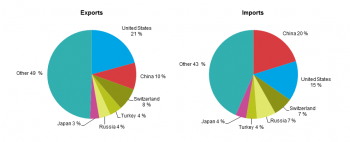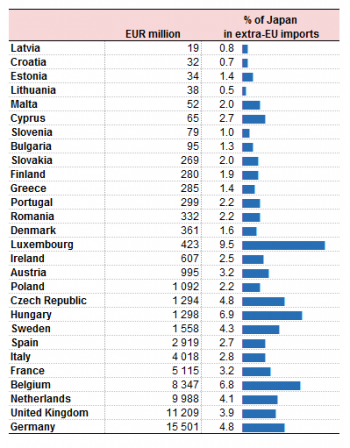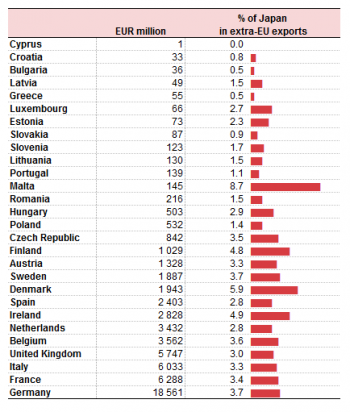Archive:Japan-EU – international trade in goods statistics
- Data extracted in September 2017. Most recent data: Further Eurostat information, Main tables and Database. Planned article update: October 2018.
This article provides a picture of the trade in goods between the European Union (EU) and Japan. It analyses the type of goods exchanged between the two economies and the shares of each EU Member State in those exchanges.
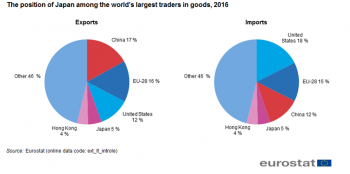
Source: Eurostat (ext_lt_introle)

Source: Eurostat (ext_lt_introle)
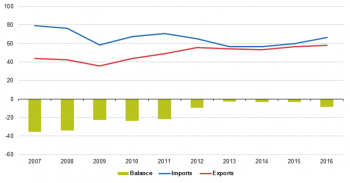
Source: Eurostat (ext_lt_maineu)
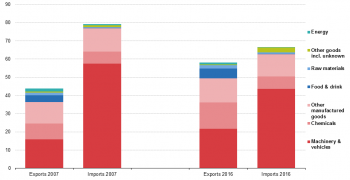
Source: Eurostat DS-018995
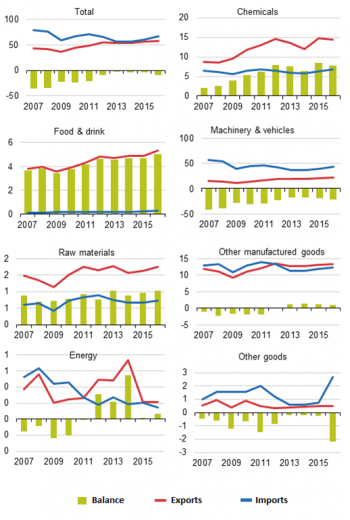
Source: Eurostat DS-018995

Source: Eurostat (ext_st_eu28sitc)
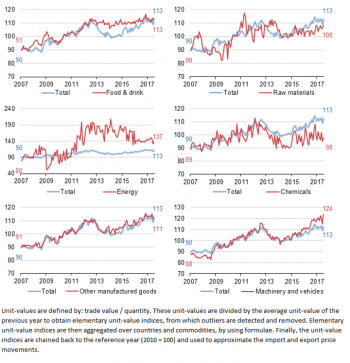
Source: Eurostat (ext_st_eu28sitc)
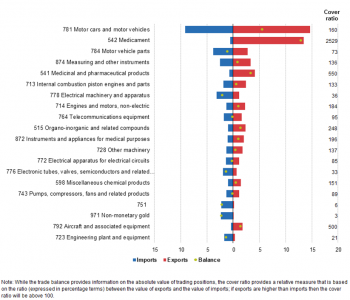
Source: Eurostat DS-018995
Main statistical findings
- In 2016, Japan was both the 4h largest exporter and importer of goods in the world with a share of 5.2 % of world exports and 4.7 % of world imports.
- Among EU's trading partners, Japan was the 6th largest partner both for EU exports and EU imports, in 2016.
- EU trade balance with Japan, has been in surplus since 2007, it stood at EUR 113 billion in 2016.
- Manufactured goods dominate both the exports of goods from the EU to Japan and imports from Japan to the EU, accounting for 85 % of the total exports and 94 % of total imports.
- Among EU Member States in 2016, the Germany (imports EUR 16 billion, exports EUR 19 billion) was the largest EU trade partners of Japan. Germany also has the largest trade surplus (EUR 3 billion) with Japan, while the Netherlands has the large trade deficit (EUR 7 billion).
EU and Japan in world trade in goods
Figure 1 shows that the five largest traders account for more than half of the world exports and imports. In both cases Japan was the fourth largest accounting for one twentieth of all goods exported and imported. In exports it is preceded by China (17 %), the EU (16 %) and the United States (12 %) and followed by Hong Kong (4 %). In imports it is preceded by the USA (18 %) leads, the EU (15 %) and China (12 %) and Japan (5 %) and again followed by Hong Kong (4 %).
Figure 2 focuses on the evolution of trade in the EU and Japan over the period 2007-2016. Between 2007 and 2014 Japan's imports grew more rapidly than its exports and consequently its cover ratio (exports divided by imports), which had been above 100 % until 2011, dropped to 85 % in 2014. However in 2015 and 2016 Japan's imports dropped while its exports continued to grow. so that its cover ratio reached 106 % in 2016. For the EU the cover ratio was below 85 % in 2007 and only rose to 103 % in 2013 due to strong export growth, in 2016 it dropped slightly to 102 %.
EU deficit for the fourth year in a row
Figure 3 shows that in 2016, Japan had a share of 3.3 % in extra-EU exports (EUR 58 billion) and 3.9 % in extra-EU imports (EUR 67 billion). This meant it was the sixth largest partner for imports and exports with the EU, in both cases ahead of Norway which was ranked seventh and just after Turkey and Russia. The top five was completed by the United States, China and Switzerland.
The EU had a trade deficit with Japan from 2007 to 2016 (see Figure 4). It was lowest in 2013 at EUR 3 billion but rose again to 9 billion in 2016. In this period trade between the two economies hit a low in 2009, and only surpassed the 2007 level in 2016. However at that time imports and export had grown much closer than they had been in 2007.
EU trade with Japan largely dominated by manufactured goods
When breaking down imports and exports by SITC groups, the main categories driving the exports to and imports from Japan are ‘Machinery and vehicles’ (SITC 7), ‘Chemicals’ (SITC 5) and ‘Other manufactured goods’ (SITC 6&8). Together they accounted for around 85 % of the EU exports and 95 % of imports (see Figure 5). Compared to 2007 this meant that in exports the share grew by 2 % while in imports it fell by 2 %.
Figure 6 shows the evolution of EU imports and exports by SITC group since 2007. In 'machinery and vehicles' which is the most trade group, the EU had a trade deficit of EUR 42 billion in 2007 which reduced to EUR 17 billion in 2014 but rose again to 22 billion in 2016. In 2016 the only other group were EU trade was in deficit was 'other goods' while in chemicals, other manufactured goods, food & drink and energy the EU registered trade surpluses of different sizes.
Figure 7a shows the unit value index for EU imports from Japan by SITC group. For most of the SITC groups the evolution is fairly similar to the unit value index at total trade level. Only for energy are there large fluctuations, possibly due to price fluctuations on world markets. In machinery and vehicles and other manufactured goods, the unit value indexes remain close to the total index. However in 2016 for chemicals and raw materials, it was eight points and six points below the total index respectively. This indicates that prices of chemicals and raw materials imported from Japan rose less than the average prices of imports.
On the export side, the largest fluctuations are also observed for energy (see figure 7b). In 2016 in 'machinery and vehicles' the unit value index was eleven points higher than the one for total exports while in chemicals it was 15 points below. Comparing imports and exports for these two groups shows that in machinery and vehicles the index for exports was 10 points higher than in imports while in chemicals the index for exports was 7 points lower than in imports
Apart from the unit value indexes shown here, Eurostat also produces seasonally and/or working day adjusted volume indexes for imports and exports of goods. A selection of these is available here. The complete set of indexes dataset can be found online in table ext_st_eu28sitc.
Most traded goods: Motor cars and motor vehicles
Figure 8 gives more details about the goods exchanged between the EU and Japan, showing the top 20 traded goods at a more detailed level (by SITC level 3). Those top 20 goods covered around 56 % of total traded goods in 2016. Thirteen products among the top 20 belong to the ‘Machinery and transport equipment’ group and five to 'chemicals'. 'Motor cars and motor vehicles' both the most imported and exported product.
Another interesting way to look at data is to investigate the export/import ratio of traded goods, in order to better identify the direction taken by flows and specialisation between the two areas. These ratios can be found in the right margin of Figure 8. For the top product, 'Motor cars and motor vehicles', the ratio equals 80 meaning that for every 100 euros of imports from Japan the EU exports 80 euros to Japan. Several other products have ratios between 40 and 300 indicating trade flows in both directions. A ratio of more than 300 is only found in medicaments (SITC 542) while ratios below 30 are found for motor cycles (SITC 785), engineering and plant equipment (SITC 723), office machines (SITC 751) and non-monetary gold (SITC 971).
Germany is the Member State trading most with Japan
Figure 9a shows Member States' imports from Japan and the share of the partner Japan in national extra-EU imports. Table 9b provides similar information but concerning Member States' exports to Japan.
There are six Member States whose imports from Japan in 2016 were higher than EUR 4 billion: the Germany, the United Kingdom, the Netherlands, Belgium, France and Italy. Together they accounted for more than 80 % of imports from Japan. The share of Japan in extra-EU imports was highest for Luxembourg (9 %) and lowest for Lithuania (0.5 %)
The same six Member States were also the largest exporters to Japan but in a different order, although Germany was again the largest. Their combined share in exports to Japan was a little over 75 %. The share of Japan in extra-EU exports was highest for Malta (9 %) and lowest for Cyprus (0.04 %)
Figure 9c shows that 14 Member States had a trade surplus with Japan in 2016, ranging from just EUR 0.1 million for Croatia to EUR 3 060 million for Germany (EUR 3 504 million). The other 14 Member States had a trade deficit, starting at EUR - 58 million for Bulgaria to EUR - 7 billion for the Netherlands. The United Kingdom and Belgium (both EUR 5 billion) were the only other two countries whose deficit was higher than EUR 1 billion.
Data sources and availability
EU data is taken from Eurostat's COMEXT database. COMEXT is the reference database for international trade in goods. It provides access not only to both recent and historical data from the EU Member States but also to statistics of a significant number of third countries. International trade aggregated and detailed statistics disseminated via the Eurostat website are compiled from COMEXT data according to a monthly process.
Data are collected by the competent national authorities of the Member States and compiled according to a harmonised methodology established by EU regulations before transmission to Eurostat. For extra-EU trade, the statistical information is mainly provided by the traders on the basis of customs declarations.
EU data are compiled according to Community guidelines and may, therefore, differ from national data published by the Member States. Statistics on extra-EU trade are calculated as the sum of trade of each of the 28 EU Member States with countries outside the EU. In other words, the EU is considered as a single trading entity and trade flows are measured into and out of the area, but not within it.
Data for the other major traders are taken from the Comtrade database of the United Nations. Data availability differs among countries, therefore Figure 1 shows the latest common available year for all the main traders. For the calculation of shares the world trade is defined as the sum of EU trade with non-EU countries (source: Eurostat) plus the international trade of non-EU countries (source: IMF Dots database).
Methodology
According to the EU concepts and definitions, extra-EU trade statistics (trade between EU Member States and non-EU countries) do not record exchanges involving goods in transit, placed in a customs warehouse or given temporary admission (for trade fairs, temporary exhibitions, tests, etc.). This is known as ‘special trade’. The partner is the country of final destination of the goods for exports and the country of origin for imports.
Product classification
Information on commodities exported and imported is presented according to the Standard international trade classification (SITC). A full description is available from Eurostat’s classification server RAMON.
Unit of measure
Trade values are expressed in millions or billions (109) of euros. They correspond to the statistical value, i.e. to the amount which would be invoiced in case of sale or purchase at the national border of the reporting country. It is called a FOB value (free on board) for exports and a CIF value (cost, insurance, freight) for imports.
Context
Trade is an important indicator of Europe’s prosperity and place in the world. The block is deeply integrated into global markets both for the products it sources and the exports it sells. The EU trade policy is an important element of the external dimension of the ‘Europe 2020 strategy for smart, sustainable and inclusive growth’ and is one of the main pillars of the EU’s relations with the rest of the world.
Because the 28 EU Member States share a single market and a single external border, they also have a single trade policy. EU Member States speak and negotiate collectively, both in the World Trade Organization, where the rules of international trade are agreed and enforced, and with individual trading partners. This common policy enables them to speak with one voice in trade negotiations, maximising their impact in such negotiations. This is even more important in a globalised world in which economies tend to cluster together in regional groups.
The openness of the EU’s trade regime has meant that the EU is the biggest player on the global trading scene and remains a good region to do business with. Thanks to the ease of modern transport and communications, it is now easier to produce, buy and sell goods around the world which gives European companies of every size the potential to trade outside Europe.
See also
Further Eurostat information
Data visualisation
Main tables
- International trade in goods (t_ext_go), see:
- International trade in goods - long-term indicators (t_ext_go_lti)
- International trade in goods - short-term indicators (t_ext_go_sti)
Database
- International trade in goods (ext_go), see:
- International trade in goods - aggregated data (ext_go_agg)
- International trade in goods - long-term indicators (ext_go_lti)
- International trade in goods - short-term indicators (ext_go_sti)
- International trade in goods - detailed data (detail)
- EU trade since 1988 by SITC (DS-018995)
Dedicated section
Methodology / Metadata
- International trade in goods statistics - background
- International trade in goods (ESMS metadata file — ext_go_esms)
- User guide on European statistics on international trade in goods
Source data for tables, figures and maps (MS Excel)
External links
- European Commission
